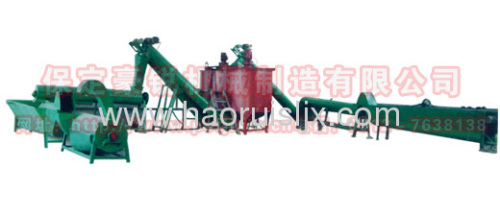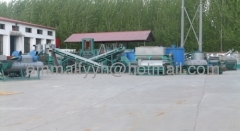
|
Baoding Haorui Machinery Manufacturing Co., Ltd.
|
Pet cleaning line economy
| Payment Terms: | T/T,L/C,WU, |
| Place of Origin: | Hebei, China (Mainland) |
|
|
|
| Add to My Favorites | |
| HiSupplier Escrow |
Product Detail
a tank separates different materials by their density,light material is discharged from the end of the tank while heavy material is discharged by bott
1 Granulator/Shredder
a wet grinding machine equipped with V-cutting technology rotor and flame treatment
2 Turbo washer
high speed washing machine with screen washes material.a part of dirt comes out from the screen with water.
3 sink floating tank
a tan separates different materials by their density,light material is discharged from the end of the tank while heavy material is discharged by bottom and side screws.
4 spiral washer
to wash material again in order to warrant the cleanness.
5 mechanical dryer
dewatering step,taking out water by high speed centrifuge.
6 thermal dryer
another dryer but with electrical heater to further dry the material by high temperature.
7 packaging unit
double output allow bagging twice in one batch.
Pet cleaning equipment economy,
1. This machine line is used for waste bottles which need to be crushed, washed, dryed.
2. Production Capacity: 300-3000kg/h (without label remover machine).
3. It has the advantages of high quality, high efficiency, competitive price, loe energy consuming, low in noise, short delivery time, ect.
4. If you want to know more details, please contact with me without hesition.
We can also manufacture as the request of clients'

Pet cleaning equipment economy
a wet grinding machine equipped with V-cutting technology rotor and flame treatment
2 Turbo washer
high speed washing machine with screen washes material.a part of dirt comes out from the screen with water.
3 sink floating tank
a tan separates different materials by their density,light material is discharged from the end of the tank while heavy material is discharged by bottom and side screws.
4 spiral washer
to wash material again in order to warrant the cleanness.
5 mechanical dryer
dewatering step,taking out water by high speed centrifuge.
6 thermal dryer
another dryer but with electrical heater to further dry the material by high temperature.
7 packaging unit
double output allow bagging twice in one batch.
Pet cleaning equipment economy,
1. This machine line is used for waste bottles which need to be crushed, washed, dryed.
2. Production Capacity: 300-3000kg/h (without label remover machine).
3. It has the advantages of high quality, high efficiency, competitive price, loe energy consuming, low in noise, short delivery time, ect.
4. If you want to know more details, please contact with me without hesition.
We can also manufacture as the request of clients'
The codes on plastic recyclable containers are what help most in the sorting and separating process. The six categories of plastics are separated into two areas: polyethelyne plastics and polymer plastics. The polyethelyne plastics are labeled HDPE, for high density polyethelyne; or LDPE, for low density polyethelyne. The four polymer plastics that are recycled include polyvinyl chloride, labeled V; polystyrene, labeled PS; polypropylene, labeled PP; and polyethylene terephthalate, labeled PETE. These names and labels can seem confusing, but they are a necessity in the recycling process.
There are four types of recycling processes that usually occur: primary, secondary, tertiary, and quaternary. The primary recycling process is recycling materials and products that contain similar features of the original product. This process is only feasible with semi-clean industrial scrap plastics, therefore this process is not widely used. Secondary recycling allows for a higher mixture of combination levels in plastics. When the secondary process of recycling is used it creates products such as fenceposts and any products that can be used in the substitution of wood, concrete, and metal. The low mechanical properties of these types of plastics are the reason why the above products are created. Tertiary recycling is occurring more and more today because of the need to adapt to the high levels of waste contamination. The actual process involves producing basic chemicals and fuels from plastic. The last form of recycling is the quarternary process. This quarternary process uses the energy from plastic by burning. This process is the most common and widely used in recycling. The reason this process is widely used is because of the high heat content of most plastics. Most incinerators used in the process can reach temperatures as high as 900 to 1000 degrees Celsius. For the sake of the environment the new techniques being used with the incinerators have decreased the amount of air pollutants being released.

Pet cleaning equipment economy
Didn't find what you're looking for?
Post Buying Lead or contact
HiSupplier Customer Service Center
for help!
Related Search
Pet Cleaning
Pet Cleaning Brush
Pet Cleaning Towel
Pet Cleaning Wipe
Pet Hair Cleaning
Pet Bottle Cleaning
More>>





















